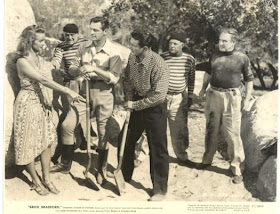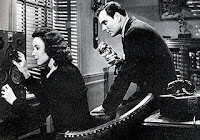 |
| Stuart Whitman vs. a ticked off baboon |
SANDS OF THE KALAHARI (1965). Director: Cy Endfield.
This was one of two heavily promoted desert/plane crash movies released in 1965, the other being The Flight of the Phoenix. In this a group of travelers, told their regular flight has been delayed, decide to continue on in a small charter plane. Unfortunately said plane runs into a swarm of locusts which clog the engines and cause the craft to crash in the middle of the Kalahari desert. Unlike Phoenix, this picture includes a pretty blond (Susannah York) for some of the men to fight over. Stuart Whitman plays a nasty character who forces one older man (Theodore Bikel) to march through the desert at gun point to try to get help after the pilot, who set off on a similar journey, doesn't come back. [What happens to the pilot is quite ironic.] Eventually a battle of wills develops between Whitman and the remaining passengers, especially Mike Bain (Stanley Baker), who rightly sees the man as the dangerous nut that he is. A miscast Whitman is only adequate in the role of the basically sociopathic O'Brien, and at times York doesn't seem to know what to make of her helpless and unsympathetic character. Baker, Bikel, and Harry Andrews as a German passenger are all excellent. Although the advertisements for the film played up the presence of dangerous baboons in the area, these animals really haven't much to do until the very end of the picture. [Killer baboons later showed up in In the Shadow of Kilimanjaro.]
Verdict: Man vs. man with nature waiting in the wings. ***.














